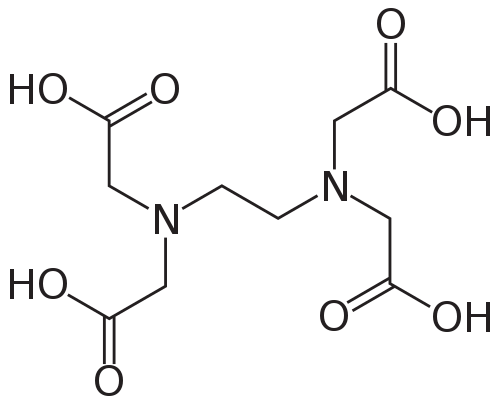
EDTA - Ethylenediaminetetraacetic acid
A natural form of chelation.
Chelation, (pronounced key-lay-shun) therapy uses chelating agents to effectively remove heavy metals, such as mercury, cadmium, nickel, copper, lead and others from the body. A chelate is a chemical compound in which the central atom, usually a metal ion, is attached to neighboring atoms by at least two bonds in such a way as to form a ring structure. Chelating is the process in which the metal ion reacts with another molecule to form the chelate. EDTA, (ethylenediaminetetraacetic acid) is an amino acid. It was synthesized in Germany in 1935 and first patented in the U.S. in 1941. Chelation therapy itself can be understood simply as the removal of calcium deposits, (from your arteries, where you don’t want them) and other harmful minerals that promote blood clotting and atherosclerosis. Since these harmful deposits are also known to cause excessive free radical production, EDTA chelation also functions as a powerful free radical buster … protecting cell membranes, DNA, enzyme systems, and lipoproteins from the destructive effects of these ravenous molecules. Using the basic man made amino acid, this process has the unique ability to bind with divalent metals, including calcium, that have accumulated in the body to excess levels. None of the calcium that is removed is found bound in bones and teeth, but rather only metastatic or pathogenic calcium that is causing damage to the body. An example of these are bursitis and bone spurs. Arteriosclerosis, or clogged arteries lined with plaque respond very well to this treatment. The chelation agent binds together with the coating of plaque that clogs the intimal and medial layers of diseased blood vessels, like a magnet bonding with iron shavings. Then the cleansing action of the blood moves these out of the body via the kidneys and bowels. Patients also see an overall improvement in circulatory function by restoring new elasticity to the blood vessel walls. Chelation therapy has also been used successfully to treat myocardial and coronary insufficiency, Alzheimer’s disease, rheumatoid arthritis, Lupus, kidney and gallbladder stones, cataracts, glaucoma, macular degeneration, heart arrhythmias, hypercalcemia and any other condition which is caused by a disruption of blood flow because of atherosclerotic plaque, excessive calcium ion concentration, a sluggishness of the parathyroid glands in calcium metabolism, or a lack of collateral circulation.
It is important to include antioxidant vitamins and minerals while using the EDTA.
1000 mg (2 capsules) of bee pollen, 1000 mg of Vitamin C, 400 mg Magnesium, 500 Mg Vitamin E, and 6-8 glasses of water daily.
The recommended dose of EDTA for most adults is 500 to 1000mg per day. Always start with the lowest dose and gradually work your way up over time to avoid any potential side effects. The typical time table for following this protocol is 6-8 weeks.
The most common side effect reported is upset stomach at very large doses.
Those with decreased kidney function should not use EDTA.
